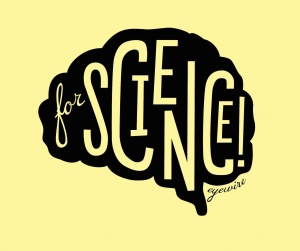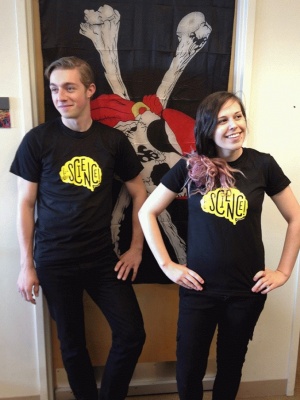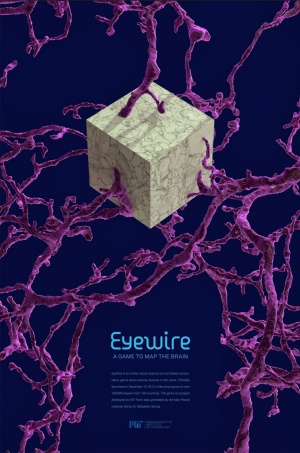Difference between revisions of "Meet the Lab"
(→GrimReaper) |
(Added link to relevant page.) |
||
| (20 intermediate revisions by 6 users not shown) | |||
| Line 1: | Line 1: | ||
| − | + | <translate> | |
| − | + | <!--T:1--> | |
| − | + | [[File:Eyewire_for_science.jpg|thumb|EyeWire: For Science! by Beth Almeida]] | |
| − | + | <!--T:2--> | |
| + | [[File:Designers_seung_lab.jpg|thumb|A couple rebels from EyeWire HQ]] | ||
| − | + | Here in the EyeWire lab, we aim to go a step beyond the NIH initiative: our challenge is to understand not only regional connections in the brain, but the connections between individual neurons. Our first effort involves tracing the connections in the retina by analyzing images acquired using serial electron microscopy at the Max Planck Institute for Medical Research in Heidelberg, Germany. In order to accomplish this, we have formed a diverse team of scientists, software engineers, artists and social networking experts, and have together created EyeWire! | |
| + | ====Our Fearless Leader==== <!--T:3--> | ||
| + | [[Sebastian Seung]] is a Korean American multi-disciplinary expert whose research efforts have spanned the fields of neuroscience, physics and bioinformatics. Dr Seung is Professor of Computational Neuroscience in the Department of Brain and Cognitive Sciences and the Department of Physics at the Massachusetts Institute of Technology. He studied theoretical physics with David Nelson at Harvard University and completed postdoctoral training with Haim Sompolinsky at the Hebrew University of Jerusalem. Before joining the MIT faculty, he was a member of the Theoretical Physics Department at Bell Laboratories. He has been a Packard Fellow, Sloan Fellow, McKnight Scholar, Howard Hughes investigator, and PopTech Science Fellow. Dr Seung directs the scientific programs of WiredDifferently, an organization that supports citizen neuroscience. Its first project is Eye Wire, which mobilizes volunteers to map the retinal connectome. The ultimate goal of WiredDifferently is to test the hypothesis that the uniqueness of a person, from memories to mental disorders, lies in his or her connectome. His research has been communicated to the general public by the TED talk [http://www.ted.com/talks/sebastian_seung.html "I am my connectome"], book Connectome: How the Brain's Wiring Makes Us Who We Are, and article [http://www.dana.org/news/cerebrum/detail.aspx?id=13758 Connectomics: Tracing the Wires of the Brain.] | ||
| − | ====Development==== | + | ====Development==== <!--T:4--> |
| − | + | Will and Katya work tirelessly on EyeWire. All of the software for the site was the product of years of work from our developers, previously including Mark aka echo. Today, they are working to improve the efficiency and user experience with the website by continuing to work on both the UI/UX and software on the EyeWire site. | |
| − | ==== | + | ====Neuroscience and Computer Science==== <!--T:5--> |
| − | + | ||
| − | + | <!--T:6--> | |
| − | + | Currently, Uygar, Aleks, Kisuk, Ashwin, Talmo and Matt are working to improve the segmentation of neural structures in EM images. One means of doing this involves comparing the efficiency of convolutional neural networks with that of more classical algorithms. The ultimate goal is to optimize automation of EM image analysis. Jinseop is EyeWire's lead neuroscience postdoc. | |
| − | + | <!--T:7--> | |
| − | [[File: | + | [[File:Eyewire_purple_cube_poster.jpg|thumb|EyeWire Poster by Alex Norton]] |
| − | + | ====Strategic Development==== <!--T:8--> | |
| + | Amy leads EyeWire's external collaborations with groups ranging from TED to the National Academies of Sciences. She is an expert in crowdsourcing who also contributes to social media, the EyeWire blog and keeping people engaged. | ||
| − | + | ====Design ==== <!--T:9--> | |
| + | Alex, Beth, Sam, Luke and Brad lead design and animation at EyeWire. They are responsible for our many gorgeous images, movies, posters, UI/UX design and even the EyeWire Swag Shop. We couldn't have won the National Science Foundation's International Visualization Challenge without them. | ||
| − | + | ====Game Masters==== <!--T:10--> | |
| + | Rachel, Marissa, Celia, Doug, and Devon are EyeWire's resident game masters. Our new minions include Mike, Merlin, Kyle, and Ben. These geniuses run competitions and happy hour, keep chat in line, oversee game progress, reap cells, declare neurons complete, answer your questions and so much more.. | ||
| − | + | <!--T:11--> | |
| + | Eventually we'd like to automate analysis of SEM image sets, unfortunately that's not yet possible. As a result, we have a number of advanced tracers in the lab who use software developed in the lab (affectionately referred to as "[[Tracing_using_Omni|Omni]]" - derived from connectOMe) to trace the branches of retinal neurons and ganglion cells. Think of it like EyeWire's much bigger brother. | ||
| − | The | + | ====Education ==== <!--T:12--> |
| + | Claire works on spreading EyeWire to students. Claire taught a [[MOSTEC]] class in 2012. The class introduced neuroscience and connectomics to 24 high school students from underserved communities nation-wide. She is now creating an edX course on the neuroscience of vision. | ||
| − | + | ====UROPS ==== <!--T:13--> | |
| + | Many MIT Undergraduates have contributed to EyeWire over the years. EyeWire's awesome legions include Aaron, Matt, Barbie and Dmetri. | ||
| + | |||
| + | ====Special Thanks==== <!--T:14--> | ||
| + | Michael Purcaro, David Jia, Brett Warne and Rachel Shearer participated in early work on software development. Daniel Berger has assisted with 3D renderings. EyeWire is based on images of the retina acquired at the Max Planck Institute of Medical Research in Heidelberg, Germany by Kevin Briggman, Moritz Helmstaedter, and Winfried Denk using a method known as serial block-face scanning electron microscopy. | ||
| + | |||
| + | <!--T:15--> | ||
| + | EyeWire is currently funded by the National Institutes of Health, and was originally made possible by support from the Gatsby Charitable Foundation, the Howard Hughes Medical Institute, and the Max Planck Society. | ||
| + | |||
| + | <!--T:16--> | ||
| + | Former team members: Mark Richardson, Leandro Burnes, Srini Turaga, Matt Susskind | ||
| + | |||
| + | <!--T:17--> | ||
| + | Special Thanks: Elizabeth Bailey, Rachel Cuozzo, Alan Diaz-Romero, Emilio Gonzalez, Jonathan Gootenberg, Shaunak Kishore, Yinqing Li, Greg Lubin, Tomer Mangoubi, Claire O’Connell, Ami Patel, Laya Rajan, Christopher Smith, Jacob Steinhardt, Jessica Sun, Arvind Thiagarajan, and Jason Toy | ||
| + | |||
| + | ====[[GrimReaper]]==== <!--T:18--> | ||
| + | |||
| + | <!--T:19--> | ||
| + | A mysterious, deadly creature with a propensity for old english and destroying mergers. | ||
| + | </translate> | ||
Latest revision as of 05:38, 30 January 2019
Here in the EyeWire lab, we aim to go a step beyond the NIH initiative: our challenge is to understand not only regional connections in the brain, but the connections between individual neurons. Our first effort involves tracing the connections in the retina by analyzing images acquired using serial electron microscopy at the Max Planck Institute for Medical Research in Heidelberg, Germany. In order to accomplish this, we have formed a diverse team of scientists, software engineers, artists and social networking experts, and have together created EyeWire!
Contents
Our Fearless Leader
Sebastian Seung is a Korean American multi-disciplinary expert whose research efforts have spanned the fields of neuroscience, physics and bioinformatics. Dr Seung is Professor of Computational Neuroscience in the Department of Brain and Cognitive Sciences and the Department of Physics at the Massachusetts Institute of Technology. He studied theoretical physics with David Nelson at Harvard University and completed postdoctoral training with Haim Sompolinsky at the Hebrew University of Jerusalem. Before joining the MIT faculty, he was a member of the Theoretical Physics Department at Bell Laboratories. He has been a Packard Fellow, Sloan Fellow, McKnight Scholar, Howard Hughes investigator, and PopTech Science Fellow. Dr Seung directs the scientific programs of WiredDifferently, an organization that supports citizen neuroscience. Its first project is Eye Wire, which mobilizes volunteers to map the retinal connectome. The ultimate goal of WiredDifferently is to test the hypothesis that the uniqueness of a person, from memories to mental disorders, lies in his or her connectome. His research has been communicated to the general public by the TED talk "I am my connectome", book Connectome: How the Brain's Wiring Makes Us Who We Are, and article Connectomics: Tracing the Wires of the Brain.
Development
Will and Katya work tirelessly on EyeWire. All of the software for the site was the product of years of work from our developers, previously including Mark aka echo. Today, they are working to improve the efficiency and user experience with the website by continuing to work on both the UI/UX and software on the EyeWire site.
Neuroscience and Computer Science
Currently, Uygar, Aleks, Kisuk, Ashwin, Talmo and Matt are working to improve the segmentation of neural structures in EM images. One means of doing this involves comparing the efficiency of convolutional neural networks with that of more classical algorithms. The ultimate goal is to optimize automation of EM image analysis. Jinseop is EyeWire's lead neuroscience postdoc.
Strategic Development
Amy leads EyeWire's external collaborations with groups ranging from TED to the National Academies of Sciences. She is an expert in crowdsourcing who also contributes to social media, the EyeWire blog and keeping people engaged.
Design
Alex, Beth, Sam, Luke and Brad lead design and animation at EyeWire. They are responsible for our many gorgeous images, movies, posters, UI/UX design and even the EyeWire Swag Shop. We couldn't have won the National Science Foundation's International Visualization Challenge without them.
Game Masters
Rachel, Marissa, Celia, Doug, and Devon are EyeWire's resident game masters. Our new minions include Mike, Merlin, Kyle, and Ben. These geniuses run competitions and happy hour, keep chat in line, oversee game progress, reap cells, declare neurons complete, answer your questions and so much more..
Eventually we'd like to automate analysis of SEM image sets, unfortunately that's not yet possible. As a result, we have a number of advanced tracers in the lab who use software developed in the lab (affectionately referred to as "Omni" - derived from connectOMe) to trace the branches of retinal neurons and ganglion cells. Think of it like EyeWire's much bigger brother.
Education
Claire works on spreading EyeWire to students. Claire taught a MOSTEC class in 2012. The class introduced neuroscience and connectomics to 24 high school students from underserved communities nation-wide. She is now creating an edX course on the neuroscience of vision.
UROPS
Many MIT Undergraduates have contributed to EyeWire over the years. EyeWire's awesome legions include Aaron, Matt, Barbie and Dmetri.
Special Thanks
Michael Purcaro, David Jia, Brett Warne and Rachel Shearer participated in early work on software development. Daniel Berger has assisted with 3D renderings. EyeWire is based on images of the retina acquired at the Max Planck Institute of Medical Research in Heidelberg, Germany by Kevin Briggman, Moritz Helmstaedter, and Winfried Denk using a method known as serial block-face scanning electron microscopy.
EyeWire is currently funded by the National Institutes of Health, and was originally made possible by support from the Gatsby Charitable Foundation, the Howard Hughes Medical Institute, and the Max Planck Society.
Former team members: Mark Richardson, Leandro Burnes, Srini Turaga, Matt Susskind
Special Thanks: Elizabeth Bailey, Rachel Cuozzo, Alan Diaz-Romero, Emilio Gonzalez, Jonathan Gootenberg, Shaunak Kishore, Yinqing Li, Greg Lubin, Tomer Mangoubi, Claire O’Connell, Ami Patel, Laya Rajan, Christopher Smith, Jacob Steinhardt, Jessica Sun, Arvind Thiagarajan, and Jason Toy
GrimReaper
A mysterious, deadly creature with a propensity for old english and destroying mergers.


